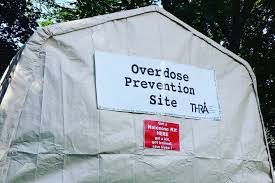 The United States has been battling a serious drug use epidemic for several years. While opioids including prescription opioids and illegal opioids like heroin and illicitly manufactured fentanyl have received significant attention, other drug use, including use of stimulants like cocaine and methamphetamine, remain major public health issues as well. Drug overdose deaths continue to increase, and more than 700,000 people have died from a drug overdose from 1999 to 2017. The majority of these drug overdose deaths involved opioids. From 1999 to 2017, almost 400,000 people died from an opioid overdose, and approximately 68% of all drug overdose deaths in 2017 involved an opioid.
The United States has been battling a serious drug use epidemic for several years. While opioids including prescription opioids and illegal opioids like heroin and illicitly manufactured fentanyl have received significant attention, other drug use, including use of stimulants like cocaine and methamphetamine, remain major public health issues as well. Drug overdose deaths continue to increase, and more than 700,000 people have died from a drug overdose from 1999 to 2017. The majority of these drug overdose deaths involved opioids. From 1999 to 2017, almost 400,000 people died from an opioid overdose, and approximately 68% of all drug overdose deaths in 2017 involved an opioid.
Drug overdose deaths demand an effective public health response, but it is also important to address infectious diseases associated with drug use. As a consequence of the opioid and drug use epidemic, HIV infections among people who inject drugs (PWID) is a growing area of concern. Data show that HIV infections among PWID are increasing in a number of jurisdictions. Massachusetts has experienced recent increases in new HIV infections among PWID in multiple areas across the state. In 2018, the Massachusetts Department of Public Health and the Centers for Disease Control and Prevention (CDC) investigated an outbreak of HIV infections among PWID in the cities of Lowell and Lawrence, involving over 150 cases between 2015 and 2018. Since mid-November 2018, a small cluster of new infections attributed to IDU has been identified in the City of Boston. From 2014 to 2017, the proportion of new HIV diagnoses in Massachusetts attributable to injection drug use increased from 5% to 17%.
Similar trends have been reported in Seattle and Philadelphia. HIV diagnoses among PWID increased nearly 300% between January and November 2018 in King County, where Seattle is located. In Philadelphia, where PWID comprised a stable 5% of the all new HIV diagnoses for years, the health department identified 46 newly diagnosed cases of HIV among PWID in a year period from September 2017 to August 2018, representing a 48% increase in new HIV diagnoses over the previous year.
To reduce the impact of HIV among PWID, harm reduction models have proven their effectiveness. The provision of sterile syringes and other harm reduction services prevents HIV and creates pathways to substance use treatment. Yet there remain significant gaps in access to these services in many parts of the country.
Overdose prevention sites, also known as safe consumption sites, are a form of harm reduction. These sites provide a hygienic space for people to use illicit drugs under the supervision of trained staff and are designed to reduce the risk of HIV and Hepatitis C transmission, prevent overdose deaths, and connect people who use drugs with addiction treatment and other social services. Efforts to implement overdose prevention sites have been limited within the United States. Additionally, overdose prevention sites have faced legal challenge. In February 2019, the United States Attorney for the Eastern District of Pennsylvania filed a civil lawsuit against Safehouse, a Philadelphia-based nonprofit that plans on operating the country’s first ever overdose prevention site, and asked a federal court to declare overdose prevention sites to be illegal under a federal statute, 21 U.S.C. 856(a), also known as the “Crack House” Statute. On October 2, 2019, the federal district court ruled that “the ultimate goal of Safehouse’s proposed operation is to reduce drug use, not facilitate it, and accordingly, §856(a) does not prohibit Safehouse’s proposed conduct.” While this court decision is an important step forward, the legal process is not over.
More work is needed to implement overdose prevention sites, syringe services programs, and other harm reduction services throughout the United States. To be successful, we need continued legal and policy advocacy as well as leadership from elected officials and community stakeholders.



